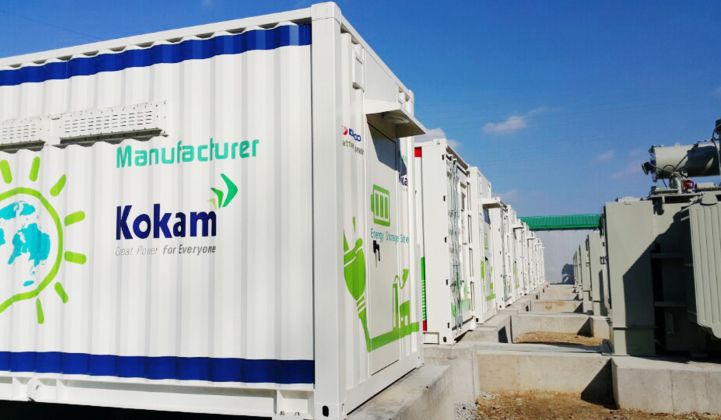A hybrid storage project is showing batteries and gas plants can coexist, even as peakers elsewhere fight for survival in the face of battery competition.
The hybrid project, developed by Alinta Energy for a gas-powered microgrid at an Australian mine, involves a 30-megawatt, 11.4-megawatt-hour power battery plant from Kokam linked to a 178-megawatt open-cycle gas turbine.
The turbine, housed at the Newman Power Station, is in the Pilbara region of Western Australia, 737 miles north of Perth, and provides all the power for an iron ore mine operated by the mining giant BHP Billiton.
The station was built in 1996 and is owned and operated by Alinta. The storage system consists of five 2.2-megawatt-hour containerized units equipped with Kokam ultra-high-power lithium-nickel-manganese-cobalt oxide (NMC) batteries.
Kokam served as the system integrator on the project, which started operating last month and also features an ABB PowerStore virtual generator for microgrid management.
It is believed to be the first gas-and-storage hybrid to be installed on a mining microgrid, as well as the largest lithium-ion battery deployed for industrial use in Australia.
There were several reasons why Alinta was interested in attaching the power battery to the gas plant, said Ike Hong, vice president of Kokam's power solutions division.
The first was for the battery to serve as an uninterruptible power supply in the event of a turbine failure, potentially safeguarding millions of dollars’ worth of output per hour.
A second motive was to improve power quality on the microgrid, providing spinning reserve, frequency regulation and voltage support.
In addition, the Kokam battery can react instantly to the mine’s changing power requirements, reducing the need for the gas turbine to ramp up and down all the time and thus improving fuel efficiency.
Hong said Alinta had not released details of the expected fuel savings from the project. He did, however, note that the applications being delivered at the Newman Power Station were more suited to high-power NMC batteries than other lithium-ion chemistries.
The Kokam batteries have a maximum discharge rate of 10 coulombs, compared to around 3 coulombs for competing lithium-ion chemistries. This means they can deliver very large bursts of energy in a short span of time.
Kokam claims its batteries can also last up to 10,000 cycles, more than double the amount for other NMC products. The Newman battery plant is expected to operate on at least a daily basis and came with a 10-year warranty.
To achieve an equivalent power output from a Tesla battery system, Hong said, Alinta would have needed to buy 50 megawatt-hours of storage, or five times the energy capacity it procured from Kokam.
The potential to improve gas plants through the addition of megawatt-scale batteries opens up a new window of opportunity for battery vendors. “We’re getting a lot of interest from other microgrid operators,” said Hong, citing offshore platforms, military installations and other mining facilities as prime candidates for hybrid storage systems.
And although batteries and gas plants are increasingly competing with each other, they are also acting in concert.
Southern California Edison and General Electric, for example, have developed two hybrid electric gas turbine units combining 50-megawatt peaker plants with batteries capable of providing 10 megawatts and 4 megawatt-hours of power. As with the Newman project, the main attraction of the GE hybrids is their ability to operate more efficiently than traditional gas turbines, using batteries as a shock absorber to deal with 15-minute to 5-minute spinning reserve signals.
The energy and marine equipment maker Wärtsilä, which bought the battery storage software developer Greensmith a year ago, is also commercializing hybrid systems combining fossil-fuel generation with batteries.
“Fast-starting, internal combustion engines integrated with energy storage offer considerable potential for fuel and cost savings,” says Wärtsilä on its website.
“Especially in remote areas, such as island and isolated grids where fuel prices are generally high, these types of integrated hybrid power plants hold great promise.”




